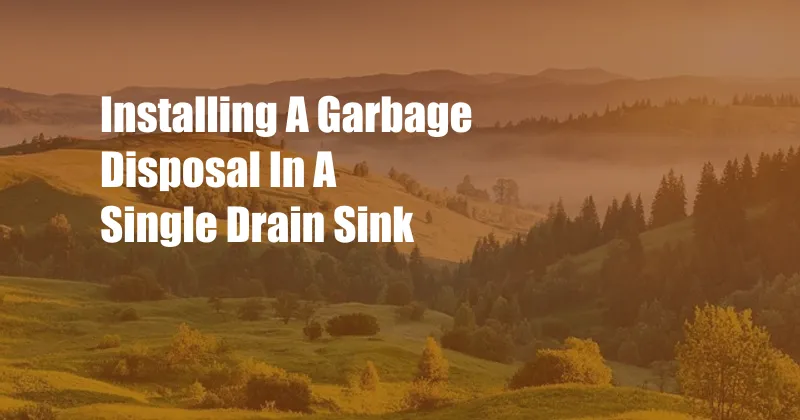
Installing a Garbage Disposal in a Single Drain Sink: A Guide for Beginners
If you’re tired of dealing with smelly, clogged drains, installing a garbage disposal is an excellent solution. While it may seem daunting, installing a garbage disposal in a single drain sink is a relatively straightforward task that can be completed with a few basic tools and a bit of patience. In this comprehensive guide, we’ll walk you through the steps involved and provide expert tips to help you get the job done right.
Before you begin, make sure you have the necessary tools and materials. You’ll need a garbage disposal unit, a mounting bracket, a sink flange, plumber’s putty, and a wrench or pliers. Additionally, you may need an adjustable wrench, a screwdriver, and a flashlight.
Choosing the Right Garbage Disposal
When selecting a garbage disposal, consider the size of your sink, the number of people in your household, and the types of food you typically dispose of. For a single drain sink in a small household, a 1/2 horsepower disposal should suffice. However, if you have a large sink, a larger household, or you frequently dispose of large amounts of food waste, you may want to opt for a more powerful model.
Garbage disposals come in three main types: continuous feed, batch feed, and instant batch feed. Continuous feed disposals operate continuously while you’re running water, while batch feed disposals require you to turn them on and off manually. Instant batch feed disposals combine the features of both types, allowing you to start and stop the disposal with a switch.
Installing the Garbage Disposal
Start by turning off the water supply to your sink. Then, disconnect the drain pipe from the sink flange and remove the existing drain stopper. Apply a generous amount of plumber’s putty to the top of the sink flange and insert it into the drain hole. Tighten the mounting bracket to the sink flange using the supplied bolts.
Next, connect the garbage disposal to the mounting bracket using the provided screws. Make sure the disposal is securely attached and that the discharge pipe is properly aligned with the drain pipe. Tighten the drain pipe to the discharge pipe using a wrench or pliers.
Once the disposal is installed, connect the electrical wires according to the manufacturer’s instructions. Most garbage disposals require a 120-volt electrical outlet. Make sure the outlet is properly grounded and that the electrical connection is secure.
Finally, turn on the water supply and check for leaks. If you notice any leaks, tighten the connections until they are snug.
Tips and Expert Advice
Here are some tips and expert advice to ensure a successful installation:
- Before you start, make sure you have all the necessary tools and materials.
- Read the manufacturer’s instructions carefully before beginning the installation.
- Wear safety glasses and gloves when working with tools.
- Turn off the water supply and electricity before disconnecting any pipes or wires.
- Apply a generous amount of plumber’s putty to the sink flange to prevent leaks.
- Tighten all connections securely, but be careful not to overtighten.
- Check for leaks after installation and tighten any loose connections as necessary.
FAQ
Q: What are the benefits of installing a garbage disposal?
A: Garbage disposals eliminate the need for scraping food scraps into the trash, reducing odors and clogging. They also help prevent sink backups and can extend the life of your plumbing system.
Q: What types of food should I avoid putting in my garbage disposal?
A: Avoid putting fibrous foods like celery and onion skins, greasy foods, bones, and coffee grounds in your garbage disposal, as they can cause clogs or damage the blades.
Q: How often should I clean my garbage disposal?
A: It’s a good idea to clean your garbage disposal every few months to prevent odors and clogs. You can clean it by running a mixture of vinegar and baking soda through it or by using a commercial disposal cleaner.
Conclusion
Installing a garbage disposal in a single drain sink is a relatively simple task that can be completed in a few hours. By following the steps outlined in this guide and using the tips provided, you can ensure a successful installation. If you encounter any difficulties, don’t hesitate to consult a qualified plumber.
Are you ready to experience the convenience of a garbage disposal in your kitchen?